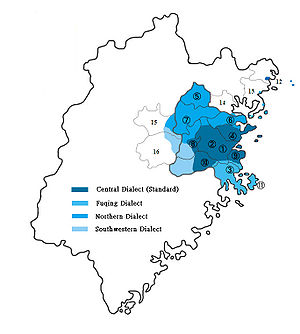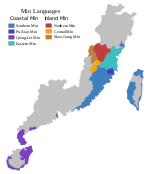lingvo.wikisort.org - Language
Eastern Min or Min Dong (traditional Chinese: 閩東語; simplified Chinese: 闽东语; pinyin: Mǐndōngyǔ, Foochow Romanized: Mìng-dĕ̤ng-ngṳ̄), is a branch of the Min group of Sinitic languages of China. The prestige form and most-cited representative form is the Fuzhou dialect, the speech of the capital of Fujian.[5]
| Eastern Min | |
|---|---|
| Min Dong (閩東語) Foochowese (福州話) | |
| 平話 | |
| Pronunciation | "Bàng-uâ" in different dialects [paŋ˨˩ŋuɑ˨˦˨] (Fuzhou) [paŋ˥ŋuɑ˦˨] (Fuqing) [paŋ˥˦˦ŋua˧˨˦] (Gutian) [paŋ˧˩ŋuɑ˩˧˩] (Matsu) [paŋ˨ɰo˧˧˨] (Ningde) [paŋ˨ɰo˨˧] (Fu'an) [paŋ˨ŋua˨˩˨] (Xiapu) [paŋ˨˩ŋua˨˩˧] (Zherong) |
| Native to | Southeast China, Taiwan, Southeast Asia, United States (chiefly New York City) |
| Region | Eastern Fujian (Fuzhou and Ningde), Matsu; parts of Taishun and Cangnan, Wenzhou, Zhejiang |
Native speakers | 9.5 million (2007)[1] |
Language family | Sino-Tibetan
|
| Dialects |
|
Writing system | Chinese characters and Foochow Romanized |
| Official status | |
Official language in | Matsu Islands, Taiwan (as local language[2])[3] |
Recognised minority language in | one of the statutory languages for public transport announcements in the Matsu Islands, Taiwan[4] |
| Language codes | |
| ISO 639-3 | cdo |
| Glottolog | mind1253 |
 Eastern Min | |
Geographic distribution
Fujian and vicinity
Eastern Min varieties are mainly spoken in the eastern part of Fujian Province (闽东) of the People's Republic of China, in and near the cities of Fuzhou and Ningde. They are also widely encountered as the mother tongue on the Matsu Islands controlled by the Republic of China. Additionally, the inhabitants of Taishun and Cangnan to the north of Fujian in Zhejiang also speak Eastern Min varieties. Eastern Min generally coexists with the official standard Chinese in all these areas.
United States
As the coastal area of Fujian has been the historical homeland of a large worldwide diaspora of overseas Chinese, varieties of Eastern Min can also be found across the world, especially in their respective Chinatowns. Cities with high concentrations of such immigrants include New York City,[6] especially Little Fuzhou, Manhattan, Sunset Park, Brooklyn and Flushing, Queens.
Europe
They are also found in various Chinatown communities in Europe, including London, Paris and Prato in Italy.[7]
Japan and Malaysia
Chinese communities within Ikebukuro, Tokyo[8] as well as Sibu, Sarawak, Malaysia have significant populations of Eastern Min speakers. Fuzhou communities can also be found in Sitiawan, Perak and Yong Peng, Johor in West Malaysia.[citation needed]
Classification
Branches

Eastern Min is conventionally divided into three branches:[9]
- Houguan dialect group (侯官片), also called the Southern subgroup, including the Fuzhou dialect, Fuqing dialect, Changle dialect, Lianjiang dialect and the dialect of the Matsu Islands.
- Funing dialect group (福寧片), also called the Northern subgroup, including the Ningde dialect and the Fu'an dialect.
- Manjiang dialect (蠻講), spoken in parts of Taishun and Cangnan, Wenzhou, Zhejiang.
Besides these three branches, some dialect islands in the southern Chinese province of Guangdong were classified as Eastern Min.[10][11] Zhongshan Min is a group of Min varieties spoken in the Zhongshan county of Guangdong, divided into three branches: the Longdu dialect and Nanlang dialect belong to the Eastern Min group, while the Sanxiang dialect belongs to Southern Min.[12][13]
Phonology
The Eastern Min group has a phonology which is particularly divergent from other varieties of Chinese. Aside from the Manjiang dialect, both Houguan and Funing groups are similar in the number of initials, with the Fu'an dialect having 17 initials, two more than the Fuzhou dialect, the additions being /w/ and /j/ or /ɰ/ as separate phonemes (the glottal stop is common to both but excluded from this count). The Manjiang dialect on the other hand has been influenced by the Wu dialects of Zhejiang, and hence has significantly more initials than the varieties of Fujian.
The finals vary significantly between varieties, with the extremes being represented by Manjiang dialects at a low of 39 separate finals, and the Ningde dialect representing the high at 69 finals.
| Types | Houguan subgroup (侯官片) | Funing subgroup (福寧片) | Manjiang (蠻講) | ||||
|---|---|---|---|---|---|---|---|
| City | Fuzhou (福州) | Fuqing (福清) | Gutian (古田) | Ningde (宁德) | Fuding (福鼎) | Fu'an (福安) | Qianku, Cangnan, Zhejiang (蒼南錢庫) |
| Number of Initials | 15 | 15 | 15 | 15 | 15 | 17 | 29 |
| Number of Finals | 46 | 42 | 51 | 69 | 41 | 56 | 39 |
| Number of Tones | 7 | 7 | 7 | 7 | 7 | 7 | 7 |
Eastern Min varieties generally have seven tones, by the traditional count (based on the four tones of Middle Chinese, including the entering tone as a separate entity). In the middle of the Qing dynasty, eight tones were attested, but the historical rising tones (上聲) re-merged.[14]
| Dark level 陰平 | Light level 陽平 | Rising 上聲 | Dark departing 陰去 | Light departing 陽去 | Dark entering 陰入 | Light entering 陽入 | |
| Fuzhou 福州話 |
˦ 44 | ˥˧ 53 | ˧˩ 31 | ˨˩˧ 213 | ˨˦˨ 242 | ˨˧ 23 | ˥ 5 |
| Fu'an 福安話 |
˧˧˨ 332 | ˨ 22 | ˦˨ 42 | ˨˩ 21 | ˧˨˦ 324 | ˨ 2 | ˥ 5 |
| Ningde 寧德話 |
˦ 44 | ˩ 11 | ˦˨ 42 | ˧˥ 35 | ˥˨ 52 | ˦ 4 | ˥ 5 |
| Fuding 福鼎話 |
˦˦˥ 445 | ˨˩˨ 212 | ˥ 55 | ˥˧ 53 | ˨ 22 | ˥ 5 | ˨˧ 23 |
| Taishun, Zhejiang 泰順 |
˨˩˧ 213 | ˧ 33 | ˦˥˥ 455 | ˥˧ 53 | ˦˨ 42 | ˥ 5 | ˦˧ 43 |
| Qianku, Cangnan, Zhejiang 蒼南錢庫蠻講 |
˦ 44 | ˨˩˦ 214 | ˦˥ 45 | ˦˩ 41 | ˨˩ 21 | ˥ 5 | ˨˩ 21 |
| Miaojiaqiao, Cangnan, Zhejiang 蒼南繆家橋蠻講 |
˧ 33 | ˨˩˧ 213 | ˦˥ 45 | ˦˩ 41 | ˩ 11 | ˥ 5 | ˩ 1 |
Sandhi phenomena
The Eastern Min varieties have a wide of range of sandhi phenomena. As well as tone sandhi, common to many varieties of Chinese, there is also the assimilation of consonants[15] and vowel alternations (such as rime tensing).
Tone sandhi across Eastern Min varieties can be regressive (where the last syllable affects the pronunciation of those before), progressive (where earlier syllables affect the later ones) or mutual (where both or all syllables change). The rules are generally quite complicated.
Initial assimilation of consonants is usually progressive, and may create new phonemes that are not phonemically contrastive in initial position but do contrast in medial position.[16] A few varieties exhibit regressive assimilation too.
See also
- Protection of the varieties of Chinese
References
- Mikael Parkvall, "Världens 100 största språk 2007" (The World's 100 Largest Languages in 2007), in Nationalencyklopedin
- 本土語言納中小學必修 潘文忠:將按語發法實施 (in Chinese)
- "國家語言發展法 第二條".
- 大眾運輸工具播音語言平等保障法
- 李如龙 Li Rulong (1994). 福州方言词典 (Rev. 1st ed.). Fuzhou: Fujian People's Press (福建人民出版社). p. 1. ISBN 7211023546.
- Guest, Kenneth J. (2003). God in Chinatown: Religion and Survival in New York's Evolving Immigrant Community ([Online-Ausg.]. ed.). New York: New York University Press. p. 48. ISBN 0814731546.
- Pieke, Frank. "Research Briefing 4: Transnational Communities" (PDF). Transnational Communities Programme, Institute of Social and Cultural Anthropology, Oxford. Archived from the original (PDF) on 4 March 2016. Retrieved 2 March 2015.
- Wong, ed. by Bernard P.; Chee-Beng, Tan (2013). Chinatowns around the world gilded ghetto, ethnopolis, and cultural diaspora. Leiden [etc.]: Brill. p. 251. ISBN 978-9004255906.
{{cite book}}:|first1=has generic name (help) - Kurpaska, Maria (2010). Chinese language(s) : a look through the prism of the great dictionary of modern Chinese dialects ([Online-Ausg.]. ed.). Berlin: De Gruyter Mouton. p. 71. ISBN 9783110219142.
- Bodman, Nicholas C. (1984). "The Namlong Dialect, a Northern Min Outlier in Zhongshan Xian and the Influence of Cantonese on its Lexicon and Phonology". Tsing Hua Journal of Chinese Studies. 14 (1): 1–19.
- Bodman, Nicholas C. (1985). "The Reflexes of Initial Nasals in Proto-Southern Min-Hingua". In Acson, Veneeta; Leed, Richard L. (eds.). For Gordon H. Fairbanks. Oceanic Linguistics Special Publications. Vol. 20. University of Hawaii Press. pp. 2–20. ISBN 978-0-8248-0992-8. JSTOR 20006706.
- Bodman, Nicholas C. (1984). "The Namlong Dialect, a Northern Min Outlier in Zhongshan Xian and the Influence of Cantonese on its Lexicon and Phonology". Tsing Hua Journal of Chinese Studies. 14 (1): 1–19.
- Bodman, Nicholas C. (1985). "The Reflexes of Initial Nasals in Proto-Southern Min-Hingua". In Acson, Veneeta; Leed, Richard L. (eds.). For Gordon H. Fairbanks. Oceanic Linguistics Special Publications. Vol. 20. University of Hawaii Press. pp. 2–20. ISBN 978-0-8248-0992-8. JSTOR 20006706.
- 李, 含茹. "苍南蛮话语音研究--《复旦大学》2009年硕士论文". CDMD.cnki.com.cn.
- Yuan, Bixia; Wang, Yizhi (2013). "On the Initial Assimilations of Eastern Min Dialects in Fujian Province--《Dialect》2013年01期". Dialect. Retrieved 9 September 2019.
- Yang, Ching-Yu Helen (2015). "A synchronic view of the consonant mutations in Fuzhou dialect" (PDF). University System of Taiwan Working Papers in Linguistics. 8.
Further reading
- Norman, Jerry (1977–1978). "A preliminary report on the dialects of Mintung". Monumenta Serica. 33: 326–348. doi:10.1080/02549948.1977.11745053. JSTOR 40726246.
- Yan, Margaret Mian (2006). Introduction to Chinese Dialectology. LINCOM Europa. ISBN 978-3-89586-629-6.
- Akitani Hiroyuki; Chen Zeping [秋谷裕幸; 陈泽平]. 2012. The Gutian dialect of Min Dong District [闽东区古田方言研究]. Fuzhou: Fujian People's Press [福建人民出版社]. ISBN 9787211064830
На других языках
[de] Min Dong
Min Dong oder der östliche Min-Dialekt (chinesisch .mw-parser-output .Hant{font-size:110%}閩東語 / .mw-parser-output .Hans{font-size:110%}闽东语, Pinyin Mǐndōngyǔ, Min Dong: Mìng-dĕ̤ng-ngṳ̄) ist eine chinesische Sprache aus der Gruppe der Min-Sprachen. Sie wird im Nordosten der Provinz Fujian gesprochen.- [en] Eastern Min
[es] Min dong
El Min Dong o min del este (chino simplificado: 闽东语, chino tradicional: 閩東語, pinyin: Mǐndōng yǔ, BUC: Mìng-dĕ̤ng-ngṳ̄) es una lengua china principalmente hablada en el este de la provincia de Fujian (chino: 福建, pinyin: Fújiàn) en la República Popular China. Cuenta con 10 millones de hablantes. El dialecto fuzhou es una forma estándar del Min Dong.[fr] Mindong
Le mindong (ou langue min orientale, littéralement « langue de l'Est de la rivière Min », chinois simplifié : 闽东语 ; chinois traditionnel : 閩東語 ; pinyin : Mǐndōng yǔ, BUC : Mìng-dĕ̤ng-ngṳ̄) est une langue chinoise principalement parlée dans la partie orientale de la province du Fujian (chinois: 福建, BUC: Hók-gióng) en République populaire de Chine. Il compte 10 297 520 locuteurs dans le Monde et environ 10 millions en 2017 en République populaire de Chine[1]. Le dialecte de Fuzhou (Fuzhou est la capitale de la province du Fujian) est considéré comme la forme standard du mindong.[it] Lingua min dong
La lingua min orientale, o min dong (cinese semplificato: 闽东语; cinese tradizionale: 閩東語; pinyin: Mǐndōngyǔ; Foochow romanizzato: Mìng-dĕ̤ng-ngṳ̄) è la lingua parlata principalmente nella parte orientale della provincia di Fujian in Cina, a vicino a Fuzhou e Ningde. Fuzhou è la capitale e la più grande città della provincia. Il dialetto fuzhou è considerato la forma standard della lingua min orientale.[ru] Восточноминьский язык
Восточноминьский диалект (по другим классификациям — восточноминьский язык), или минь-дун, — диалект китайского языка, фактически самостоятельный язык, распространён в восточной части провинции Фуцзянь (КНР) вблизи городов Фучжоу и Ниндэ. Стандартной формой восточноминьского языка считается фучжоуский (под)диалект[en].Другой контент может иметь иную лицензию. Перед использованием материалов сайта WikiSort.org внимательно изучите правила лицензирования конкретных элементов наполнения сайта.
WikiSort.org - проект по пересортировке и дополнению контента Википедии

